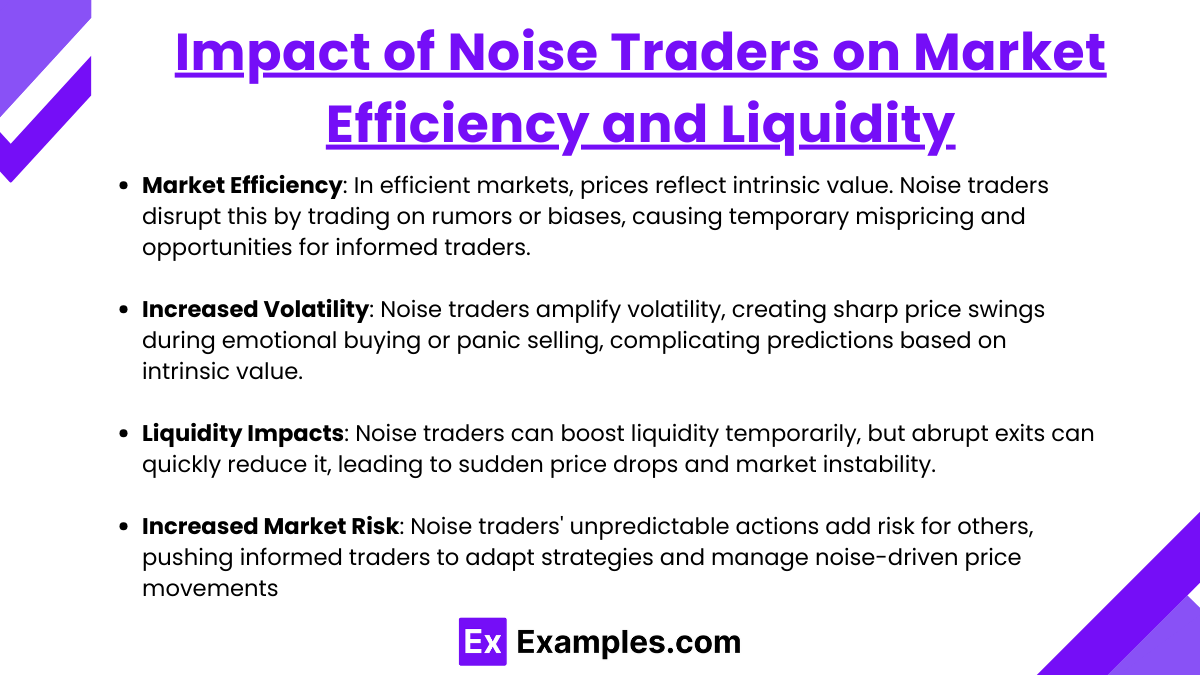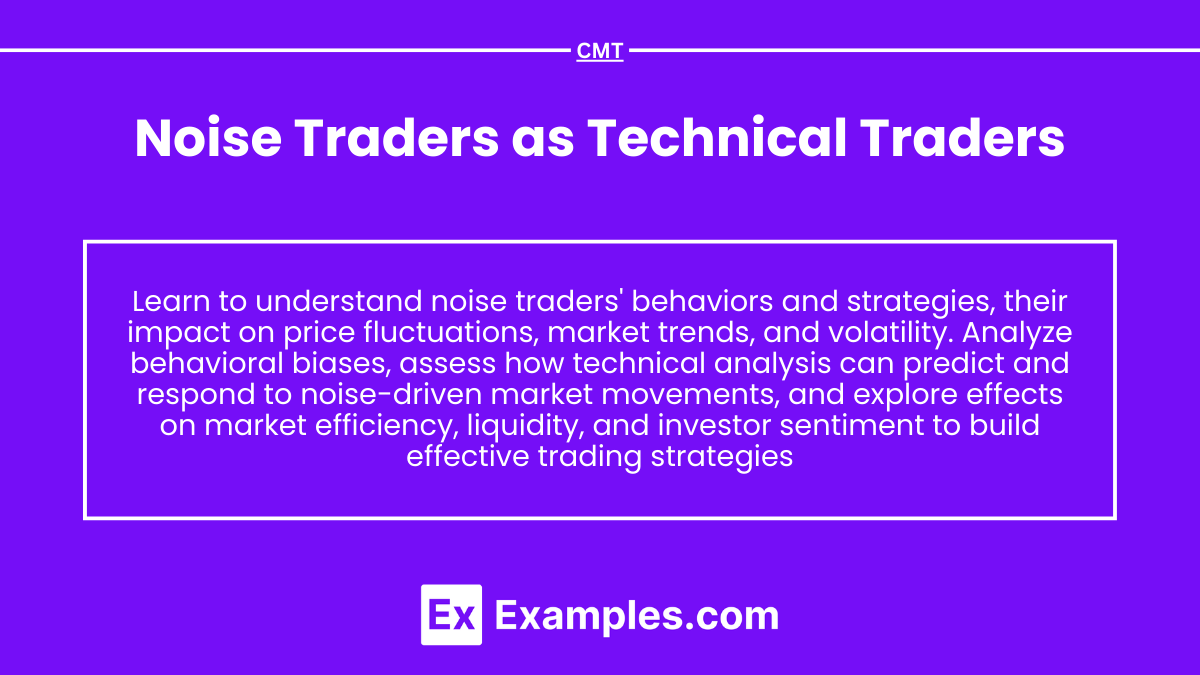“Noise Traders as Technical Traders” explores the role of traders who make decisions based on market noise rather than fundamental analysis. Understanding how these traders impact price movements and market volatility is essential for CMT Exam preparation. This knowledge aids in analyzing irrational market behavior and technical trading patterns.
Learning Objective
In studying “Noise Traders as Technical Traders” for the CMT Exam, you should learn to understand the behaviors and strategies of noise traders who base decisions on market noise instead of fundamentals. Analyze how these traders influence price fluctuations, market trends, and volatility through their irrational trading patterns. Evaluate the role of behavioral biases in noise trading and examine how technical analysis can be used to predict and respond to such market movements. Additionally, explore the impacts of noise trading on market efficiency, liquidity, and investor sentiment, applying this understanding to develop effective strategies in technical trading analysis.
Introduction to Noise Traders and Market Noise

Noise traders are market participants who make trading decisions based on factors unrelated to the fundamental value of assets, often responding to rumors, emotional impulses, or herd mentality rather than informed analysis. Unlike informed traders, who rely on concrete data and analysis of an asset’s intrinsic value, noise traders act on “market noise”—a term encompassing any irrelevant or random information influencing decision-making. This noise can include fleeting news events, speculative rumors, or simply price patterns that suggest momentum, even when no significant underlying change has occurred.
The actions of noise traders can significantly impact asset prices and market dynamics. By entering and exiting positions based on non-fundamental factors, noise traders contribute to price volatility and can create price distortions, as they might cause prices to deviate from true value temporarily. Their influence is particularly notable in high-frequency trading environments, where collective movements based on “noise” can lead to rapid price changes.
Understanding noise traders and their effect on market noise is essential in technical analysis, as it allows analysts to recognize patterns created by non-fundamental trading behavior. This knowledge helps identify potential reversals, short-term trends, and price anomalies driven by speculative rather than fundamental factors, which is key for developing effective trading strategies and managing associated risks in the market.
Behavioral Biases Influencing Noise Traders

Behavioral biases are cognitive distortions that affect how people perceive information and make decisions. In the context of noise trading, these biases drive noise traders to make market moves that aren’t aligned with an asset’s fundamental value, leading to irrational trading behavior that can impact overall market dynamics. Understanding these biases is crucial for technical analysts aiming to interpret and anticipate noise trading patterns.
- Overconfidence Bias: Overconfidence leads noise traders to believe they have better-than-average predictive abilities or access to valuable insights, causing them to take excessive risks. Overconfident traders may make frequent trades or hold onto positions based on minimal evidence, fueling market noise and potentially increasing volatility. This bias can lead to exaggerated price movements, as traders act on unfounded convictions about price trends.
- Herd Behavior: Herd behavior occurs when noise traders follow the actions of others rather than relying on individual analysis. This “follow the crowd” mentality can drive significant price swings, as traders pile into trends simply because they see others doing so. Herding is particularly powerful in speculative bubbles or panic sell-offs, where noise traders amplify both upward and downward price movements.
- Anchoring: Anchoring bias involves placing undue weight on a single piece of information, such as a specific price level or past performance, without considering other relevant data. Noise traders might anchor to a recent high or low, which can influence their decision to buy or sell, even if market conditions suggest a different course. This bias often leads to persistent price points that don’t reflect current market fundamentals.
- Recency Bias: Recency bias causes traders to overweight recent information and ignore longer-term trends. Noise traders might react strongly to a single news event or short-term price trend, expecting it to continue indefinitely. This bias can create exaggerated momentum in the market, as noise traders jump into positions based on the latest price moves, overlooking broader historical context.
These behavioral biases play a significant role in shaping the actions of noise traders, who often prioritize emotions or cognitive shortcuts over rational analysis. Recognizing these biases is essential for technical traders, as it provides insight into patterns that may not be sustainable, helping analysts forecast when noise-driven trends might reverse or lose momentum.
Impact of Noise Traders on Market Efficiency and Liquidity

Noise traders, by trading based on market “noise” rather than fundamental information, can significantly affect market efficiency and liquidity. Their actions often lead to price distortions, increased volatility, and shifts in liquidity that impact informed traders and overall market dynamics.
- Market Efficiency: In a perfectly efficient market, asset prices reflect all available information about intrinsic value. However, noise traders disrupt this efficiency by buying or selling based on factors unrelated to fundamental value, such as rumors or psychological biases. As a result, prices may diverge from true value, causing temporary mispricings. This inefficiency can create opportunities for informed traders who recognize the disparity between an asset’s price and its fundamental value, although it can also increase the risk for investors relying on market prices as accurate signals.
- Increased Volatility: Noise traders contribute to higher volatility by frequently entering and exiting positions based on emotional responses or trends. Their unpredictable trades amplify price swings and can create rapid shifts in asset prices. For instance, noise traders may drive up prices during a buying frenzy based on market hype or sharply lower them in a panic sell-off, even when the underlying asset value remains stable. This volatility can make it challenging for fundamental analysts and long-term investors to predict price movements based on intrinsic value alone.
- Liquidity Impacts: Noise traders affect market liquidity, which refers to how easily assets can be bought or sold without significantly impacting the price. In some cases, the high trading volume from noise traders can enhance liquidity, making it easier for participants to execute trades. However, this liquidity is often temporary and highly sensitive to sentiment changes. When noise traders exit the market abruptly, liquidity can dry up quickly, causing sudden price drops or gaps. This makes the market more unstable and poses risks for traders relying on steady liquidity.
- Increased Market Risk for Other Participants: The unpredictable behavior of noise traders introduces additional risks for informed traders and institutional investors. Since noise traders are not guided by fundamental analysis, their trades can result in price movements that don’t align with actual value changes, forcing informed traders to adapt strategies to account for this “irrational” influence. This additional market risk requires enhanced risk management techniques, such as the use of stop-loss orders or hedging, to guard against losses from noise-driven price movements.
Examples
Example 1
A group of traders begins buying a stock heavily due to rumors of a potential merger, despite no official announcement. Their collective buying drives up the stock price, causing a short-term spike. Technical traders observing this trend might identify it as noise and wait for a price correction before entering.
Example 2
A sudden social media post claiming that a cryptocurrency will “skyrocket” attracts a large number of noise traders. They buy into the cryptocurrency impulsively, causing a rapid price increase. Technical traders might use indicators like RSI or Bollinger Bands to identify this overbought condition and anticipate a pullback.
Example 3
After a popular financial influencer predicts a specific stock will decline, noise traders begin selling off their positions. This selling pressure temporarily lowers the stock’s price, creating a potential buying opportunity. Technical analysts may use support levels to gauge where the selling might taper off, signaling a good entry point.
Example 4
News of a new technology release leads noise traders to buy into a tech company, causing the price to rise sharply despite limited information on the release’s actual impact. Technical traders might look for a breakout pattern or wait for price consolidation after the initial surge before making a trade decision.
Example 5
During an earnings announcement period, noise traders react to headline figures, ignoring deeper insights into the company’s fundamentals. This reaction causes exaggerated price swings up or down. Technical traders might use moving averages to filter out short-term volatility and better assess the underlying trend after the announcement.
Practice Questions
Question 1
What is a primary characteristic of noise traders?
A. They rely solely on fundamental analysis.
B. They base decisions on non-fundamental information like rumors or sentiment.
C. They only trade in low-volatility markets.
D. They have a long-term investment horizon.
Answer: B
Explanation: Noise traders typically make trading decisions based on non-fundamental factors such as rumors, social sentiment, or recent market trends rather than in-depth analysis of an asset’s intrinsic value. This behavior distinguishes them from informed traders who rely on fundamental analysis.
Question 2
Which technical analysis strategy can help identify noise-driven overbought or oversold conditions?
A. Moving Averages
B. Bollinger Bands
C. Fundamental Valuation Models
D. Discounted Cash Flow Analysis
Answer: B
Explanation: Bollinger Bands are commonly used to measure price volatility and identify overbought or oversold conditions, which often occur due to noise trading. When prices move outside the upper or lower bands, it can indicate an overreaction by noise traders, signaling potential reversal points.
Question 3
How might noise traders impact market efficiency?
A. They generally have no effect on market efficiency.
B. They improve market efficiency by aligning prices with fundamentals.
C. They can create temporary mispricings by causing prices to deviate from intrinsic value.
D. They reduce volatility, making prices more stable.
Answer: C
Explanation: Noise traders can disrupt market efficiency by causing prices to fluctuate based on non-fundamental factors, such as rumors or sentiment. This behavior leads to temporary mispricings, where prices deviate from their true fundamental value, potentially creating opportunities for informed traders.


